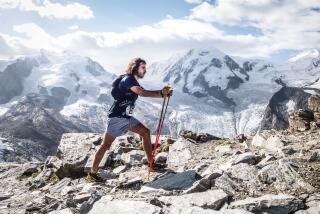Trail Runners Discover Benefits of a Scenic Route
Tired of inhaling car fumes, running in place at traffic lights and bouncing his battered bones and joints against rock-hard asphalt, Willie Guevara was ready to give his mind and body a break. So the 50-year-old marathon runner from Placentia left the clogged city streets behind for the soft, serene trails of the wilderness.
“I want to be running when I’m in my 70s,” said Guevara, who does much of his training for the Los Angeles Marathon in Brea’s hilly Carbon Canyon Regional Park. “If I stay on the streets, I don’t know if I’ll get there.”
Rebecca Grissom of Irvine, who has a lot more life in her 25-year-old legs than Guevara has in his, wasn’t looking that far down the road when she chose to start running competitively on bumpy, dusty trails rather than flat, hard pavement.
“The miles go by so quickly on the trails, because you never know what you’re going to see,” said Grissom, a former college soccer player. “It’s just a lot more adventurous with all the hills, the trees and the animals.”
It isn’t unusual for trail runners to see coyotes, bobcats, mountain lions and snakes. It also isn’t unusual for them to trip over a root, roll their ankle in a ditch or contract poison oak from a seemingly harmless bush. But that’s the trade-off many back-country running enthusiasts are beginning to take.
Ten years ago, trail running appealed almost exclusively to the “Ultra Runner,” a zealous subculture driven by the challenge of 50- to 100-mile races through the Sierra Nevada or the Cleveland National Forest. But these days, trail running is attracting conventional runners, those who prefer more manageable distances -- 5Ks, 10Ks and half-marathons.
The surge in trail running is illustrated by a 2002 Outdoor Industry Assn. survey, which reported that 6.7 million Americans consider themselves hard-core trail runners, up 40.9% from 2001. People between the ages of 16 and 34 account for 70% of trail runners.
It wasn’t that long ago that competitive trail runners had to wait months before they could find a race that wasn’t an endurance run. Now the sport’s growth can be measured by the hundreds of weekend trail races staged across the country.
In Southern California, the annual Winter Trail Run Series is based at Blue Jay campground in the Santa Ana Mountains. The races, including an 8K, 12K, 15K, half-marathon, 4 x 10K relay and a 50K, are every other Saturday from early January through late March. A 13.1-mile run is scheduled at 8 a.m. today.
Every weekend, various running clubs venture into areas normally frequented by mountain bikers, hikers and wildlife.
As the sport has grown, so has the variety and availability of the equipment. In the 1990s, most trail-running shoes looked more like hiking boots and were found only in specialty outdoor stores. Now, most sporting goods stores carry lighter off-road running shoes that are more fashionable and durable.
Bill Sumner, coach of Orange County-based Cal Coast Track Club, has only about 30 hard-core trail runners among 750 active members, but he can see the sport beginning to take off.
“The trail races get our runners away from the curbs and the gutters and the big entry fees,” Sumner said. “And there’s something about a root going across a path as opposed to the curb or the driveway. The root was there; we put in the curbs and the driveway. The trail runs are also more relaxing. It’s easier on your brain to run in the woods. And if your mind thinks it’s better, then your body will too.”
So is trail running really better for your muscles and bones? Kevin Armstrong, professor of orthopedic surgery at UC Irvine, says, technically, yes.
“Dirt is certainly softer than pavement, but the advantages have to be weighed against running on even ground,” Armstrong said. “On trails, you’re more likely to slip while running on rough spots and you’re more likely to turn your ankle, especially on a trail you don’t know.”
For some, risking injury on unmarked trails is part of the thrill.
“This sport is for people who like to dig in and work hard,” Grissom said. “You get dirty, you’re jumping over rocks and you have to have some good agility skills.”
And when you’re that much better than your competition, like Grissom has been, trail running can be a sport for loners. Two weeks ago, Grissom dusted the next-fastest woman by 9 minutes, finishing 15 kilometers in 1 hour and 11 minutes.
“I’m an outgoing person, but I enjoy the solitude sometimes,” said Grissom, who teaches severely autistic second-graders in the Newport-Mesa School District. “It’s been huge for clearing my mind of stress.”
For marathoner Guevara and others his age, it’s a relief not to be putting more stress on aging knees.
“Trail running is the future,” he said. “The Kenyans and the Mexicans have been doing it for a long time. It’s about time Americans caught on.”
More to Read
Sign up for The Wild
We’ll help you find the best places to hike, bike and run, as well as the perfect silent spots for meditation and yoga.
You may occasionally receive promotional content from the Los Angeles Times.






